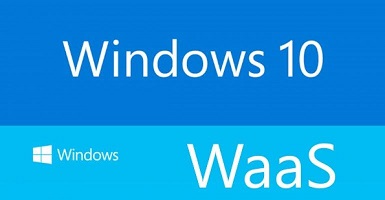Windows As A Service

Overview of Windows as a service
Windows as a service provides a new way to think about building, deploying, and servicing the Windows operating system. So, if you often find yourself wondering, “Are Windows updates necessary?” Consider this new approach. The Windows as a service model is focused on continually providing new capabilities and updates while maintaining a high level of hardware and software compatibility. Deploying new versions of Windows is simpler than ever before. Microsoft releases new features two to three times per year rather than the traditional upgrade cycle where new features are only made available every few years. Ultimately, this model replaces the need for traditional Windows deployment projects.
Prior to Windows 10, Microsoft released new versions of Windows every few years. This traditional deployment schedule imposed a training burden on users because the feature revisions were often significant. That schedule also meant waiting long periods without new features. This scenario doesn’t work well in today’s rapidly changing world. A world in which new security, management, and deployment capabilities are necessary to address challenges. Windows as a service will deliver smaller feature updates two times per year, around March and September, to help address these issues.
Deploying
Deploying Windows 10 is simpler than with previous versions of Windows. When migrating from earlier versions of Windows, an easy in-place upgrade process can be used to automatically preserve all apps, settings, and data. And once running Windows 10, deployment of Windows 10 feature updates will be equally simple.
One of the biggest challenges for organizations when it comes to deploying a new version of Windows is compatibility testing. Whereas compatibility was previously a concern for organizations upgrading to a new version of Windows, Windows 10 is compatible with most hardware and software capable of running on Windows 7 or later. Because of this high level of compatibility, the app compatibility testing process can be greatly simplified.
Servicing
Traditional Windows servicing has included several release types:
Major revisions (e.g., the Windows 8.1, Windows 8, and Windows 7 operating systems), service packs, and monthly updates. With Windows 10, there are two release types: feature updates that add new functionality twice per year, and quality updates that provide security and reliability fixes at least once a month. Are Windows updates necessary?
Naming changes
As part of the alignment with Windows 10 and Office 365 ProPlus, Microsoft is adopting common terminology to make it as easy as possible to understand the servicing process. Going forward, these are the new terms they will be using:
- Semi-Annual Channel – They will be referring to Current Branch (CB) as “Semi-Annual Channel (Targeted)”, while Current Branch for Business (CBB) will simply be referred to as “Semi-Annual Channel”.
- Long-Term Servicing Channel – The Long-Term Servicing Branch (LTSB) will be referred to as Long-Term Servicing Channel (LTSC).
Servicing tools
There are many tools with which IT pros can service Windows as a service. Each option has its pros and cons, ranging from capabilities and control to simplicity and low administrative requirements. The following are examples of the servicing tools available to manage Windows as a service updates:
- Windows Update (stand-alone) provides limited control over feature updates. IT pros manually configure the device to be in the Semi-Annual Channel. Organizations can target which devices defer updates by selecting the Defer upgrades check box in Start\Settings\Update & Security\Advanced Options on a Windows 10 client.
- Windows Update for Business is the second option for servicing Windows as a service. This servicing tool includes control over update deferment and provides centralized management using Group Policy. Windows Update for Business can be used to defer updates by up to 365 days, depending on the version. These deployment options are available to clients in the Semi-Annual Channel. In addition to being able to use Group Policy to manage Windows Update for Business, either option can be configured without requiring any on-premises infrastructure by using Intune.
- Windows Server Update Services (WSUS)provides extensive control over Windows 10 updates and is natively available in the Windows Server operating system. In addition to the ability to defer updates, organizations can add an approval layer for updates and choose to deploy them to specific computers or groups of computers whenever ready.
- System Center Configuration Manager provides the greatest control over servicing Windows as a service. IT pros can defer updates, approve them, and have multiple options for targeting deployments and managing bandwidth usage and deployment times.
Using SCCM
System Center Configuration Manager provides maximum control over quality and feature updates for Windows 10. Unlike other servicing tools, Configuration Manager has capabilities that extend beyond servicing, such as application deployment, antivirus management, software metering, and reporting. Configuration Manager can effectively control bandwidth usage and content distribution through a combination of BranchCache and distribution points. Microsoft encourages organizations currently using Configuration Manager for Windows update management to continue doing so for Windows 10 client computers.
You can use Configuration Manager to service Windows 10 devices in two ways. The first option is to use Windows 10 Servicing Plans to deploy Windows 10 feature updates automatically based on specific criteria, similar to an Automatic Deployment Rule for software updates. The second option is to use a task sequence to deploy feature updates, along with anything else in the installation.
Conclusion
Windows servicing is changing. For disaster recovery scenarios and bare-metal deployments of Windows 10, you still can use traditional imaging software such as System Center Configuration Manager or the Microsoft Deployment Toolkit. Using these tools to deploy Windows 10 images is similar to deploying previous versions of Windows. With each release of a new feature update for CB, Microsoft makes available new .iso files for use in updating your custom images. Each Windows 10 build has a finite servicing lifetime, so it’s important that images stay up to date with the latest build.
Categories
Search
Blog Categories
Related Resources
Archives
- July 2024
- June 2024
- May 2024
- April 2024
- March 2024
- January 2024
- October 2023
- September 2023
- August 2023
- July 2023
- June 2023
- May 2023
- April 2023
- March 2023
- February 2023
- January 2023
- October 2022
- July 2022
- June 2022
- May 2022
- April 2022
- March 2022
- February 2022
- January 2022
- December 2021
- November 2021
- October 2021
- September 2021
- August 2021
- July 2021
- June 2021
- May 2021
- April 2021
- March 2021
- February 2021
- January 2021
- December 2020
- November 2020
- October 2020
- September 2020
- August 2020
- July 2020
- June 2020
- May 2020
- April 2020
- March 2020
- February 2020
- January 2020
- December 2019
- November 2019
- October 2019
- September 2019
- August 2019
- July 2019
- June 2019
- May 2019
- April 2019
- March 2019
- February 2019
- January 2019
- December 2018
- November 2018
- October 2018
- September 2018
- August 2018
- July 2018
- June 2018
- May 2018
- April 2018
- March 2018
- February 2018
- January 2018
- December 2017
- November 2017
- October 2017
- September 2017
- August 2017
- July 2017
- June 2017
- May 2017
- April 2017
- March 2017
- February 2017
- January 2017
- December 2016
- November 2016
- October 2016
- September 2016
- August 2016
- July 2016
- June 2016
- May 2016
- March 2016
- February 2016
- January 2016
- December 2015
- October 2015
- September 2015
- August 2015
- July 2015
- June 2015
- May 2015
- April 2015
- March 2015
- February 2015
- January 2014
- February 2013




